Rudy Rucker's Blog, page 54
December 7, 2010
Burroughs Letters, Tangier, 1954-1956
I'm about to write a new chapter for my Turing Chronicles in the form of letters by William Burroughs—following up on my earlier chapter, "Tangier Routines".
By way of getting into the right frame of mind, today I copied out some of my favorite bits from a book I've had for nearly thirty years, William Burroughs, Letters to Allen Ginsberg 1953-1957, (Full Court Press, New York 1982). This book is out of print, but many of these letters are also in Oliver Harris (ed.), The Letters of William Burroughs 1945-1959 (Viking, New York, 1993). All of the letters I've excerpted below are from Tangier, and are to Allen Ginsberg.

6/24/54. I've been thinking about routine as an art form and what distinguishes it from other forms. One thing … it is subject to shlup over into "real" action at any time. Do you dig me? I am not sure if I dig myself. And some [poser] is going to start talking about living his art.
6/24/54. I am surrounded by curious Kafkan hostility. A number of people seem to have taken a violent, irrational dislike to me. Especially people who run bars. … This is not imagination, Allen.
8/18/54. What am I doing here, a broken eccentric, a Bowery Evangelist, reading books on Theosophy in the public library—(an old trunk full of notes in my cold water East Side flag)—imagining myself a Secret World Controller in Telepathic Contact with Tibetan Adepts … Could I ever see the merciless, cold facts on some Winter night, sitting in the operation room white glare of a cafeteria—NO SMOKING PLEASE—See the facts and myself, an old man with the wasted years, behind, and what ahead having seen the Facts?"

8/18/54. I am having serious difficulties with my novel. I tell you the novel form is completely inadequate to express what I have to say. I don't know if I can find a form. I am very gloomy as to prospects of publication … But still I need publication for development. A writer can be ruined by too much or too little success.
10/12/54 (date uncertain). Tremendous dream. … I walk along a dry, white road. There is danger here. A dry, brown vibrating in the air, like insect wings rubbing together. I pass a village of people sleeping, living under mounds—about 2 feet high—of black cloth stitched onto wire frames. … The vibrating is everywhere now—horrible, dry, lifeless. Not a sound exactly; a frequency, a wave length. The vibrating comes from a tower-like structure. A Holy Man is causing it. … I approach [the townspeople] and ask "How much will you give me to kill the Holy Man?" We … both know money is not the point.
12/13/54. You don't study Zen and then write a scholarly routine, for Christ's sake! Routines are complete spontaneous and proceed from whatever fragmentary knowledge you have. In fat a routine is by nature fragmentary, inaccurate. … Sex mixed with routines and laughter, the unmalicious, unstrained, pure laughter that accompanies a good routine, laughter that gives a moment's freedom from the cautious, nagging, aging, frightened flesh.

2/19/55. I guess all writers suffer from fear of losing their talent, because talent is something that seems to come from outside, that you have no control over.
4/20/55. Why do I always parody? Neither in life nor in writing can I achieve complete sincerity … except in parody and moments of profound discouragement.
5/17/55. Just back from 14-day cure in clinic. … Everything looks sharp and different like it was just washed. Sensations hit like tracer bullets. I feel a great intensity building up, and at the same time a weakness like I can only keep myself here, back now in this doughy, dead flesh I have been away from since the habit started.
8/10/55. [Describing a crazy man who keeps accosting him on the street.] In fact there is something curiously sweet about him, a strange, sinister jocularity, as if we knew each other from somewhere, and his words referred to private jokes from this period of intimacy. On Monday, August 1, he ran amok with a razor-sharp butcher knife in the main drag, killed 5 people and wounded four, was finally cornered by the police, shot in the stomach and captured. … I wonder if he would have attacked me? I missed him by 10 minutes. The whole town is still hysterical.
[image error]
9/21/55. [He gets very high on opiates and makes a scene at his rooming house.] I could only remember snatches of what had happened, but I do remember wondering why people were looking at me so strangely and talking in such tiresome, soothing voices.
10/21/55. [He's working on the novel he calls Interzone, and which will become Naked Lunch.] This writing is more painful than anything I ever did. Parentheses pounce on me and tear me apart. I have no control over what I write, which is as it should be.
10/23/55. I am progressing towards complete lack of caution and restraint. Nothing must be allowed to dilute my routines. I know I used to be shy about approaching boys, for example, but I cannot remember why exactly. The centers of inhibition are atrophied, occluded like an eel's ass on The Way to Sargasso—good book title. You know about eels?

10/23/55. Yesterday I took a walk on the outskirts of town. Environs of the Zone are wildly beautiful. Low hills with great variety of trees, flowering vines and shrubs, great, red sandstone cliffs topped with curiously stylized, Japanese-looking pine trees, fall to the sea. … The knife fight potential was … one facet of that moment, sitting in the café, looking out at the hill opposite, stylized pine trees on top arranged with the economy of a Chinese print against blue sky in the tingling, clear, classic Mediterranean air … I was completely alive in the moment, not saving myself, not waiting for anything or anybody … This is it right now … Actually I am so independent, so fucking far out I am subject fo float away like a balloon …
11/13/55. Arab Café: Sit down and had three words … just three long words, with Miss Green … Watching a glass of mint tea on a bamboo mat in the sun, the steam blow back into the glass top like smoke from a chimney … Some Arabs at a table .. It is unthinkable they should molest me … Suppose they do? And suddenly they have seized me, and are preparing to castrate me? It can't happen … must be a dream .. In Interzone it might or might not be a dream, and which way it falls might be in the balance while I watch this tea glass in the sun … The meaning of Interzone, its pace time location is at a point where three-dimensional fact merges into dream, and dreams erupt into the real world.
[image error]
2/26/56. When I was a child I thought you saw with your mouth. I remember distinctly my brother telling me no, with the eyes, and I closed my eyes and found out it was true and my theory was wrong.
9/13/56. [Describing a boy who wants to spend the night at his apartment after sex.] I indicate as tactfully as such a concept can be effectively indicated that I considered this project inconvenient in the widest sense. … So come along to Europe, Allen, and have a good time with the boys. I can wait. But just remember I'll always be there if you want me … creak, creak, creak … [sound of a rocking chair]
9/13/56. And you recall my dream (described in letter of 10/12/54) about the Holy man who was making with a Malignant Telepathic Broadcast? … I am developing Holy Man concept in [my novel] Interzone. Latest Control Concepts: Anyone using telepathy as means of coercion must cut himself off form all protoplasmic contacts. He must always send, but never receive … He becomes an automaton, a ventriloquist dummy, withers in orgoneless limbo.
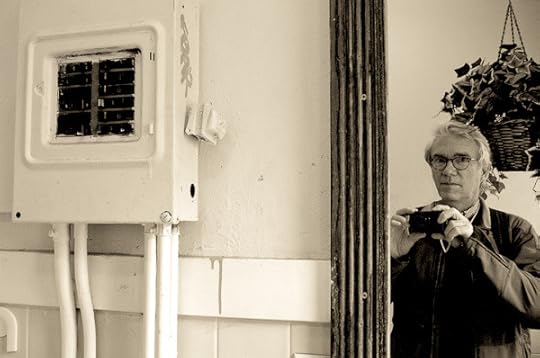
9/16/56. I find my eyes straying towards the fair sex. (It's the new frisson dearie … Women are downright piquant.) You hear about these old characters find out they are queer at fifty, maybe I'm about to make with the old switcheroo. What are those strange feelings that come over me when I look at a young [woman], little tits sticking out so cute? Could it be that?? No! No! He thrust the thought from him in horror … He stumbled out into the street with the girl's mocking laughter lingering in his ears, laughter that seemed to say "Who you think you're kidding with the queer act? I know you, baby."
10/13/56. Germs got no class to them. And the evilest of them all are the virus … So bone lazy they aren't even hardly alive yet
10/29/56. My disregard of social forms is approaching psychosis. … It's like the sight of someone about to flip or someone full of paranoid hate excites me. I want to see what will happen if they really wig. I want to crack them wide open and feed on the wonderful soft stuff that will ooze out. … Kicks, man, kicks.
December 5, 2010
Los Gatos Xmas Parade
We were at the Los Gatos Christmas parade once again on Saturday. We've been attending it off and on for twenty-four years.

The Stanford band is always a highlight, playing like crazy, dressed to kill. What energy! They're probably all A students, crazy though they look. The saxes were playing with one hand behind their back…

We always have a platoon of squash-growing Italians, as if airlifted in from the East Coast or Chicago, rough and tough, phallically thrusting their vegetables. A beauty queen rides in their Cadillac, chauffeured by a presumably venal official in a top hat.

The high-school drill teams are universal, lovely to see. I can vaguely remember being that age. The marching isn't the center of your life, it's just something you do.

I like this kid, he looks so cool. A horn man.

Back to the parade, there's these three or four older men who show up every year in a giant self-powered shiny metal duck. They're fans of the University of Oregon, who's mascot is the most famous duck of all, Donald D. I bet they work on refining the duck-car all year. It's great.

The tumblers are awesome. My autofocus has a slight delay, so I caught this young woman further into her flip than I'd expected, but this is in fact pretty cool. Gravity-defying.

There's this corner-store market on Los Gatos Boulevard, the Jiffy Mart, with a full line of liquor as well. Every year they sponsor a crew of freestyle bicyclists; they drive a pickup along the parade route with curved ramps on the front and back of the pickup, and every few dozen yards they stop, and the eager biker-boys do insane high-air flips. Very California.

And now I'm back at my desk, pecking away at The Turing Chronicles—I'm going to write a riff off a Charlie Parker reverie I saw, I'll use it for the stream of thought for Alan Turing who's disguised as a black woman inside the Sunset Lounge in 1955 West Palm Springs, Florida. I've been reading the lives of some jazz players, recently Miles Davis, and last year Charlie Parker. And here's the quote I'm eyeing, from Bird Lives, The Life of Charlie Parker, by Ross Russell (Charterhouse 1973), pl 55.
If he looked across the beams of the spotlights that shone toward the bandstand, he could see a lavender haze, shimmering like air over a street on a hot summer day. He watched the heavy smoke that curled and wreathed, floating lazily upward, borne along by the waves of music. It had a sharp, pungent, odor and made a biting sensation in the nose. It was smoke from sticks of tea that were being passed from one man to another on the bandstand below. After twenty minutes of the set Charlie would feel himself borne along in the pleasant lavender haze. Then the long narrow interior of the Reno Club would grow deeper. The bar, the polished glassware in front of the mirror, the waitresses poised like blackbirds, ready to fly to their customers—the tables, booths, dancers, musicians, orchestra, everything in the Reno Club seemed to be exactly where it belonged, as if it had been there forever and would never change, fixed in time and space, and time itself stopped. He was getting high. Now he could hear the things that he had missed, the miniature sound—Basie's little blue comments, a silvery skein of notes played by Prof as a counter line to Herschel, muted chortling of screened brass under the saxophone choir, a light scurrying of sticks across the head of the snare drum as Jesse marked off a bar section, wispy little phrases that entered somebody's mind because of something just played.

Love those sounds, Ross.
December 3, 2010
Holiday Sale on Rudy's Paintings
Get a painting for the holidays! I've slashed the prices by across the board at my Paintings Site.

The sale runs through December 31, 2010.
You can see the sale prices here.
December 2, 2010
Japonisme and Nonlinear CAs
We were in San Francisco today, taking down the paintings from my show at Borderlands Café. They still have some high-quality signed prints of my paintings on sale at Borderlands Books next door. In the photo below, note "Turing and the Skugs" on the wall.
[image error]
It was nice to be in the city for the day, on the loose. We went to see a great print show at the Legion of Honor Art Museum out on the cliffs near the Golden Gate Bridge. The show was called Japanesque—it's about Japanese prints in the time of French Impressionism. (The French used the word "Japonisme.")
[image error]
The big show-stopper is a nearly complete set of Katsushika Hokusai's series of woodcuts, each in about eight colors, 36 Views of Mount Fuji , completed in the 1830s. The most famous of these is The Great Wave, but I've posted a picture of Asakusa Temple in Edo. Actually you can see rather good images of all 36 prints on Wikipedia! The show also has an "answer" series by French artist Henri Riviere, 36 Views of the Eiffel Tower.
[image error]
I wandered into the porcelain gallery and saw this plate with Adam and Eve. Eve looks like the Headless Horseman carrying her head. Porcelain galleries are kind of interesting, so brittle and polychrome, quite unlike painting galleries.
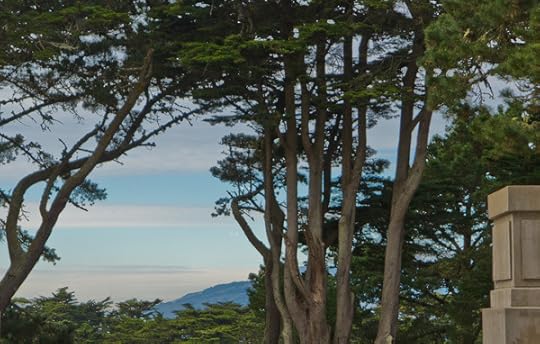
Outside the wintry sky looked like…a Japanese woodcut, with printed areas of pink among the blues, framed by the the Art Nouveau curves of the Monterey pines.

Naturally, Sylvia and I pondered creating a series, 36 Views of the Golden Gate Bridge. In this vein I should mention the wonderful California artist Tom Killion, and his series of prints, 28 Views of Mount Tamalpais, views of and on a mountain just across the Golden Gate Bridge from San Francisco. Killion's also published a related book with the poet Gary Snyder.

On the writing front, I keep rewriting a long journal note called, "What's the Plot Again?" about my plans for The Turing Chronicles. This material is a little too detailed and preliminary to put up in a blog post—I'll only quote the start:

I'm getting close to being a third of the way through The Turing Chronicles, and I need to think about the plot some more. Once again I've reached what the writer Robert Sheckley used to call a "black point." I'm not at all sure where to go.
So, okay, fall back on craft. Around the end of the first third, a book needs a conflict, a bump, an unforeseen development. So far it's been pretty straight-ahead. Turing learns to tweak biocomputations, he creates a skug, the skug can convert humans into shapeshifting skuggers. Now the plot thickens. Somehow.

I have picked out a car for Alan and his companions to drive, heading from Palm Beach to Los Alamos, New Mexico. It's a 1955 Pontiac Catalina that I found for sale online.
It goes almost without saying that the skugs are, being 1950s mutants, really into nukes, and therefore into visiting the Los Alamos National Laboratories. They plan to get some kind of boost from nuclear power or from a nuclear bomb. Alan takes advantage of his new friend Ned Strunk's Los Alamos connections—Ned underwent training there to be a nuclear-reactor tech for the Nautilus submarine.
[image error]
I think Alan, posing as a woman, gets hired to work at Los Alamos as, get this, a programmer. Stanislaw Ulam, mathematician and co-inventor of the hydrogen bomb, had a woman assistant who coded up his nonlinear wave equation simulation for him. "We wish to thank Miss Mary Tsingou for efficient coding of the problems and for running the computations on the Los Alamos MANIAC machine," reads a footnote in E. Fermi, J. Pasta, and S. Ulam, "Studies of Nonlinear Problems", published in 1955, and based on work done in 1952.

This paper is dear to my heart, I spent a number of years creating the cellular automata package Capow (still free online for Windows), for viewing Ulam's creations. See also my own paper on this topic, "Continuous Valued Cellular Automata for Nonlinear Wave Equations," co-authored with the mathematician Daniel N. Ostrov.
[image error]
Alan becomes Ulam's programmer, and works on nonlinear wave equations for use in creating, I dunno, small hydrogen bombs that fit inside lightbulbs for illuminating the home? Perhaps, along the way, Alan so improves his skug technology that skugs can be inhabited not only by human minds but by aethereal, invisible beings. And maybe in a Pied Piper ending, Alan creates some bomb-that's-not-a-bomb that lures all the skugs to their demise like moths to aflame, like the children of Hameln into the cave beneath the mountain.
"Getting a little skuggy in here, isn't it?"
November 29, 2010
Skuggers
I'm still working on my novel, The Turing Chronicles, one scene at a time.

I need a word for the people who've been taken over by skugs. They aren't exactly skugs themselves; I think of a pure skug as being one of those globs that doesn't necessarily have any human personalities inside it. When a skug eats you, you are a skug, yes, but you're also to some extent yourself, in that you can look like yourself and act like yourself.
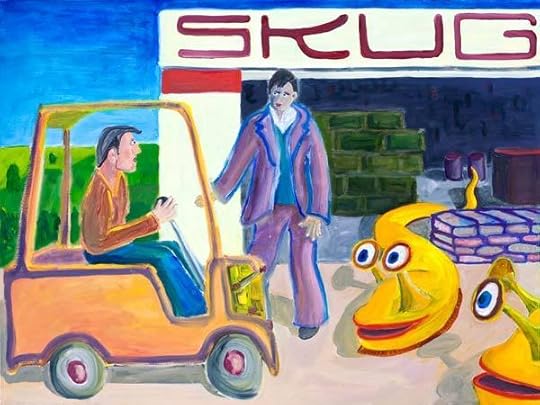
"Turing and the Skugs", 40″ x 30″ inches, Oct 2010, Oil on canvas." Click for larger version. The painting itself will be on display as part of my show at Borderlands Cafe on Valencia St. in SF, CA, until December 1. More info on my paintings site.]
I'll go with skugger. "He's a skugger," sounds right. "She's a skugger, too." There's an echo of slugger, which suggests a heavy hitter. I do like the er ending, which suggests an on-going activity. Like "bopper" in the Wares. Bopping it up. Skugging it up.

Speaking of nomenclature, I think I'll use skug as a verb to describe the act of turning someone into a skugger. "They skugged her." "I got skugged, too, man. It's great." I think of the lyrics to Bob Dylan's song, "Rainy Day Women #12 & 35". Here's a verse with "skug" instead of "stone," and with the second to last line changed for the sake of the rhyme.
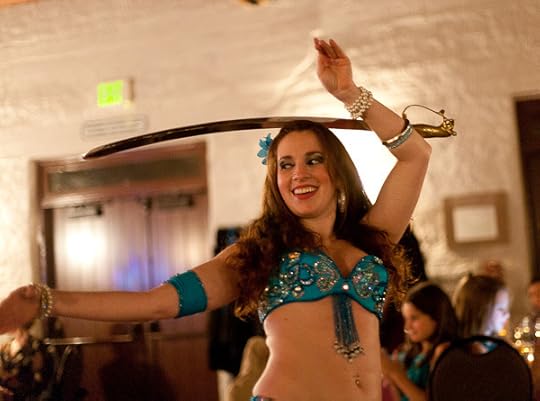
Well, they'll skug ya when you're walkin long the street
They'll skug ya when you're tryin to keep your seat
They'll skug ya when you're walkin on the floor
They'll skug ya when you're walkin to the door
But I would not feel like such a grub
Everybody must get skugged
[image error]
We can suppose that the skuggers like to band together. They're an endangered minority, at least for now. And I think that it'll soon be clear that they're bent on world domination, as befits their role as objective correlatives for the 50s bogeymen: intellectuals, artists, racial minorities, communists, dope-fiends and homosexuals. "Everybody must get skugged."
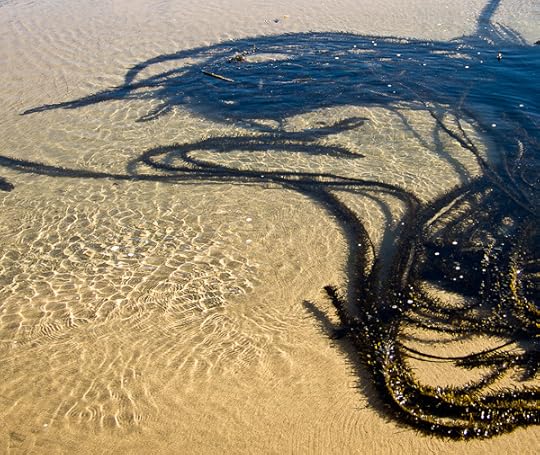
As the book goes on, I want Alan to realize that the skugs have very powerful minds, more so than he anticipated. Their high intelligence is due to (i) parallelism, that is, they're using each organic cell as a computing unit and (ii) connectivity, that is, via radio waves, they're in touch with each other, and with as much of the human data-base as is being broadcast on radio, TV and telephone.

When imagining the skug experience of hearing all the radio stations at once, I think of Patti Smith's album, Radio Ethiopia…
November 26, 2010
Wolfram's Teachings. Natural Language.
I'm thinking about the mathematician/computer-scientist/physicist Stephen Wolfram today, as his company just released version 8 of the Mathematica program, a multi-faceted mathematics-helper program; it simplifies and solves algebraid equations and generates very nice graphs, among otheg things. Wolfram's latest wrinkle is that Mathematica now (to some extent) understands natural language. So you can ask it, for instance, to draw something for you without having to use the precise Mathematica-language symbolism. Wolfram has a blog post about this, "The Free-Form Linguistics Revolution in Mathematica."

[Some of today's photos are partly drawn from a large Thanksgiving Day gathering we went to in the Mission yesterday, organized in part by my son Rudy.]
Over the years, Wolfram's had a huge influence on my thinking. Indeed, my 2006 tome, The Lifebox, the Seashell and the Soul was to a large extent inspired by Wolfram's even fatter 2002 book, A New Kind of Science
As the years go by, I'm a little surprised by how slowly our new ideas seem to be sinking in. It's as if people never will understand that a deterministic system can be unpredictable, and that computer science has pretty well established this as empirical fact. Or that natural systems in particular, being computation universal, are inherently unpredictable. So the media is always furiously casting about for the proximate cause of the latest disaster.
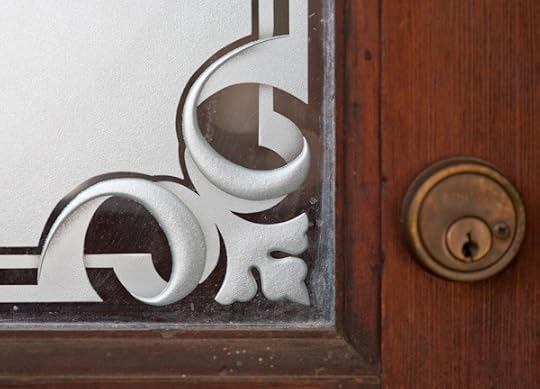
Re. my impatience, Wolfram recently emailed, "It will come. But I think the bigger the concepts, the longer the time needed for humans to absorb. So we're mostly just learning that these are in fact big concepts (even though to you and me they now seem pretty obvious)…"
For today's post, I thought I'd summarize Wolfram's tenets once again, drawing on a version that I recently wrote up for my forthcoming autobiography, Nested Scrolls: A Writer's Life. The context of this passage is that I'm recalling my mixed success in proselytizing Wolfram's teachings, as presented in his New Kind of Science book. Some audiences had been actively hostile.
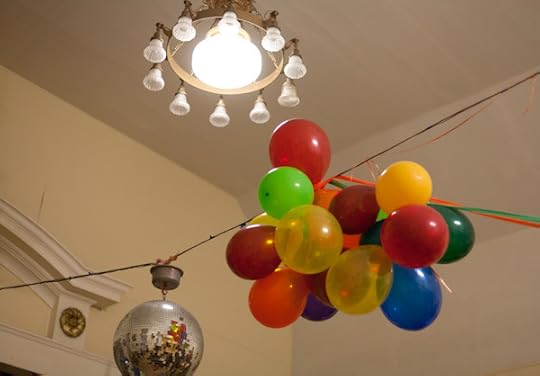
First of all, Wolfram was arguing that we can think of any natural process as a computation, that is, you can see anything as a deterministic procedure that works out the consequences of some initial conditions. Fine. Instead of saying the world is made of atoms or of curved space or of natural laws, let's see what happens if we say it's made of computations. This notion gets some people's goat, but if you've hung around computers a lot, it seems semi-reasonable.

Secondly, Wolfram made the point that, by studying cellular automata, he'd learned that there are basically three kinds of computations. The simple ones peter out or repeat themselves. The pseudorandom ones generate a seething mess. And the interesting computations lie in between. They generate patterns that seem to have some kind of structure to them, but they don't repeat themselves or turn boring.
This second idea is simply a taxonomic observation about the kinds of things we find in the world. The in-between computations are akin to what we might earlier have called chaotic processes. I myself came to call them "gnarly computations." So, if everything is to be a computation, then pretty much all of the interesting patterns in nature and biology are gnarly computations. Fine.

Thirdly, Wolfram argued that all gnarly computations are in some sense equally powerful, that is, given enough time and space, any given gnarly computation can in fact emulate any of the others. If everything is an equally-powerful computation, then we're all in some sense the same.
Note that a computer doesn't have to be made of wires and silicon chips in a box. A cloud can emulate an oak tree, a flickering flame can model a human mind, a dripping faucet can behave like the stock market. And we're not talking about vague, metaphorical resemblances here, we're talking about mathematically precise bit-for-bit representations. (I wrote about this idea in my recent pair of novels Postsingular and Hylozoic.)
For someone who'd become as steeped in computer science as I had, this third point also seemed reasonable, but outsiders had trouble making sense of it—and in their confusion, many of them grew angry.
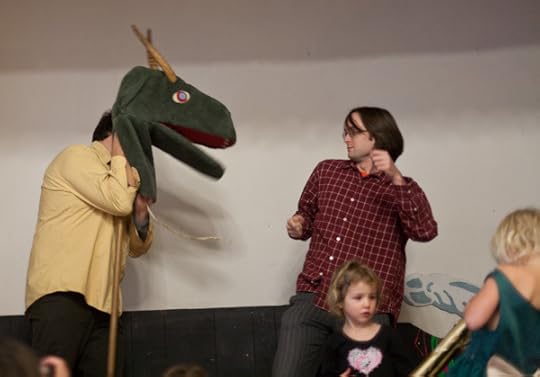
Fourthly, Wolfram said that gnarly computations are unpredictable in the specific sense that there are no quick short-cut methods for finding out what these kinds of computations will do. The only way, for instance, to really find out what the weather is going to be like tomorrow is to wait twenty-four hours and see. The only way for me to find out what I'm going to put into the final paragraph-sized "scroll" of Nested Scrolls is to finish writing the book.
Wolfram's fourth point is very nearly provable on the basis of some well-known theorems from computer science but, again, many scientists don't like it. They still subscribe to the pipedream of finding some magical tiny theory that will allow them to make quick pencil-and-paper calculations about every aspect of the future. They haven't taken to heart the essentially chaotic nature of the world. We can't control; we can't predict—but even so we can hope to ride the waves.
November 23, 2010
Four Mile Beach, Reunion, Lightroom
We were out at Four Mile Beach north of Santa Cruz yesterday with my big brother, Embry.
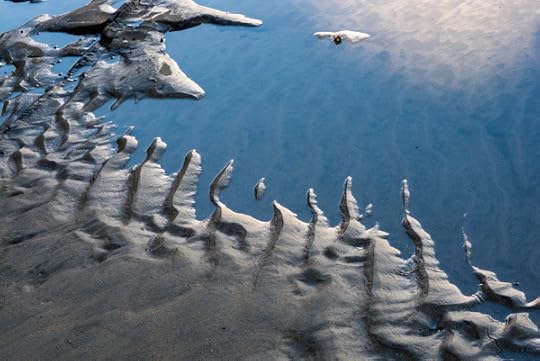
I shot some nice photos, using my pocket Canon S90 in RAW mode, and editing the RAW images in Adobe Lightroom. The camera's RAW images have 14 bits per pixel instead of the default 8 that JPGs have, that is, so RAW images have, I guess, sixty-four times as many possible shades per pixel, which helps, especially in recovering stuff from underexposed or blown-out areas.

This is an interesting shot of scattering gulls, although weakened by being a detail of a larger shot. This is where having your four-pound SLR along could kick it up a notch. But I don't geek it that hard most days. A flock of maybe a thousand gulls were sitting on the beach, all their little stick legs parallel lines above the sand. Caw, skirl, skree.
I'm still getting used to using Lightroom, it's a different paradigm than I'm accustomed to with my old Photoshop workflow. In Lightroom now, I shoot in RAW mode, save this as a "digital negative," or "DNG," then tweak this image as much as I like in Lightroom, which has a very nice "Developer" module. The original bytes are unchanged, but you see previews of the tweaked image in Lightroom and you can export 16-bit TIFF or 8-bit JPG files as if you were making "prints" from the digital negative.
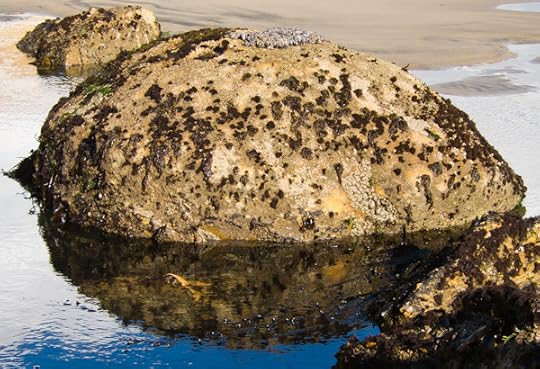
Here's your Thanksgiving turkey with barnacle garnish.
Certain of the more heavy-duty Photoshop tweak tools aren't available in Lightroom, so once in a while I might export a TIFF and do a further tweak in Photoshop. But this isn't happening as often as I thought it would. I can pretty much live in Lightroom now.
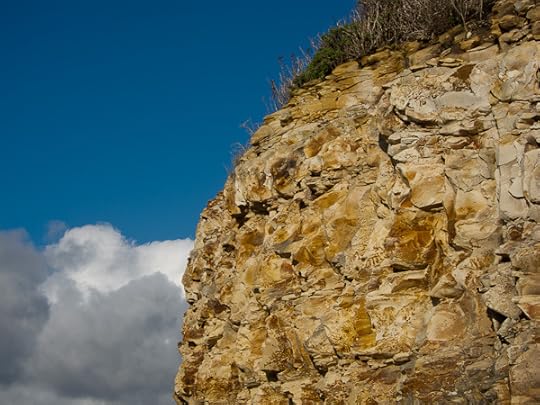
I love Four Mile Beach, it's a favorite spot, usually fairly uncrowded. On big wave days you'll see a lot of surfers—the surfers are generally friendly or indifferent to mere beach walkers.
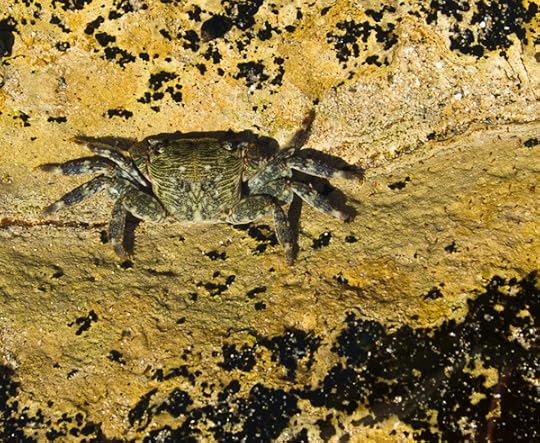
Embry spotted this cute little crab. For crustacean-ovores: the big California Dungeness crabs are in the supermarkets now, we got a bunch of them for a family dinner the other night. Really good.

My son's chickens are a little uneasy these days, but they're safe. It's great so see the granddaughters collecting their eggs.
My father, the first of the four Embry Cobb Ruckers, loved William Saroyan's book, The Human Comedy, and often quoted from a passage where a four-year-old boy finds a fresh-laid egg. "He looked at it a moment, picked it up, brought it to his mother and very carefully handed it to her, by which he meant what no man can guess and no child can remember to tell."

The years flow by; the holidays come at us like tracer bullets. We advance towards the dark. And sometimes it's still sunny.
November 18, 2010
3 AM Interview. Sex Like A Slug.

Isn't this a cool image? It's a chrome bumper on a truck in Bezerkistan.
There's a nice email interview with me by Maxi Kim in the 3 AM webzine. They found some links to videos of my talks that I'd never seen.

Did I show you my Halloween pumpkin yet? He didn't live long, his skull rotted out very quickly. Lovely sick juice ooze out.

This show shows the shadow of a Viking warrior stalking a hen for Thanksgiving dinner. "The goose hangs high" means, some say, that the fowl is hung, dead, outside for several days to ripen and soften until it's smell is — high.
"Have you bathed lately?" "I'm high on life."
[image error]
I used to think it was a good idea to go to Death Valley, but after my last visit, in September, I'm kind of over it. Well, it's nicer in the spring.
Following a suggestion by my loyal reader "Alex," I read a little of Iain M. Bank's first SF novel, Concerning Phlebas, which has a shapeshifter or "Changer" as a character. In this novel, the shapeshifting is quite slow; it takes several days, like a process of biological growth. But I'm going to want the shapeshifting to be fast, like for Plasticman. Something that I can use from Concerning Phlebas is that a shapeshifter needs to focus fairly steadily on their desired form. I like that idea.

[Rudy in grad school, 1971]
Since my fictional character Alan Turing's norm is to change shape very rapidly, it could be that any sudden shock can distract Alan from maintaining, say, his Abby shape, and he could then revert to his default Alan shape with the abruptness of a Zeeman catastrophe machine settling into a new minimal energy configuration.
[image error]
Thinking of the next scene now. Neddy Strunk, who's become a shapeshifter too, slimes up the wall of the Burroughs house, and into Alan's second-story room. Alan is backing off. Neddy takes on his Strunk look, and Alan is, like, oh no. Seeing this, Neddy has the idea of taking on a crude approximation of Vassar's appearance, Vassar being a man whom Alan is hot for. He embraces Alan and, almost against his own will, Alan finds himself slipping into the female Abby shape that he's been using to get it on with Vassar. Soft mood music.

They're screwing, but it's more than that, it's skug conjugation. They're exchanging cytoplasm. On an impulse, Alan shoots a tendril *thwap* upwards to stick to the ceiling of the Burroughs guest bedroom, and Neddy does the same. They dangle in the air, slowly twisting, like a pair of mating hermaphroditic slugs (check out the video if you've never seen it, this one complete with plummy Brit narration). And that's when Mrs. Burroughs and young Billy Jr. walk in on them.

The wild thing is—after this sight, mother Laura still thinks that this is her son William Burroughs, even though it's Alan in the Abby shape deformed into a dangling skug. I mean, that's the kind of guy that Bill is, right? He does this kind of stuff. Laura Lee throws him out of the house.
November 15, 2010
Wild West #10. Canyon du Chelly, Peyote.
One last post of photos from our September roadtrip through the Wild West. After Monument Valley, we headed south to Canyon de Chelly, pronounced like Canyon du Shay. You can find links to the complete set of Wild West posts here.

Canyon de Chelly is what you might call a box canyon, in that you can walk or drive in from the lower, open end, and its about a thousand feet deep at the upper end, which is maybe twenty miles in.

Unlike the kind of canyon that has a river in a rocky gorge at the bottom, the Canyon de Chelly is fairly flat at the bottom; it floods every year, and there's a smooth later of rich soil. People have lived and farmed in there for a very long time—in fact this may be the oldest continuously inhabited spot in the US.

The present inhabitants tend to move out during the spring months when it floods, but in the old times, the natives dealt with this by putting their homes in big cracks of the sheer cliffs.
We stayed at the nearby Thunderbird Lodge—a nice thick-walled motel built around a former trading post. The Lodge runs tours into the canyon, but they didn't look too comfortable; you sit in a chair on the back of a large flatbed truck with no shade. For about the same price, we got a Navaho guide to take us on a jeep tour, just her and Sylvia and me.

She was a lively, talkative sort, and told a lot of interesting things. She'd been off the rez for many years, but was back now, and living with the Navajo owner of the small tour company.
As we got deeper into the canyon, it started feeling ever-heavier and more spiritual. As we looked at the ruins of some cliff-dwellings, a big raven coasted past. It was so quiet in the canyon that I could hear the air on the feathers of his wings.

I'd heard that the Navajos are still into taking peyote, and I asked our guide about it. She said, yes, it was common, more among the men, and that the man she lived with was in fact a psychic guide, what they call a peyote road man. There's even a legal exemption that allows Navajos to possess and use peyote, based on membership in the Oklevueha Native American Church.
Our guide mentioned that they have go down to Texas in order to get the peyote, which grows wild along the banks of the Rio Grande River, and this can be problematic, as the legal exemption isn't necessarily honored by the Texas state authorities.
[image error]
This all reminded me of the fall of 1965—forty-five years earlier—when I myself had taken peyote. I mentioned this to our guide, but she didn't want to have that conversation.
The sun was setting as we drove back out the mouth of the Canyon de Chelly. Some wild dogs appeared by the jeep barking at us. The guide said, "I've never seen those guys before." The sun was shining into my eyes, lighting up the crannies of my brain.
"This has been great," I said. "We saw the houses of the Old Ones, the Magic Raven, and the Secret Dog Guardians are ushering us out!" She laughed. It was an amazing trip.

Rooting around today as I make this blog post, I found the manuscript of a memoir I wrote in 1983, All the Visions, typing it in a continuous session in one giant paragraph on an eighty-foot-long roll of paper. The book appeared from a small press in 1991, and is still available on Amazon, mostly in used editions. I might do an e-book release of it sometime this year. Anyway, here's an excerpt of the parts about my peyote trip in 1965, when I was a junior at Swarthmore College.
[image error]
This upperclassman Freddy had these round steel-rimmed glasses, and always an unbuttoned button-down collar shirt with the sleeves rolled high up over his elbows, the elbows jerking out to the sides make room, make room, chuckling and working on incomprehensible letters to like the FBI to leave him alone, or studying, frame by frame, a Marvel Comic. "This one is about a trip, man, you see how the guy gets on the abandoned subway and it's full of monsters?" That was indeed the trip I got one morning in 1965 when I fell by Freddy's room, looking for excitement, and he gets out a cardboard box of peyote buds.
[image error]
"These come from Texas, the Wild Zag Ranch, you send off for them, they're still legal. Spit out the hairs when you chew, the hairs have strychnine." I'm chewing the stuff, feeling myself passing through another interface, this is real. Freddy was making me nervous, jerking his elbows and peering at me, so I went down to the lobby to phone Sylvia, off at grad-school in Connecticut. But I took some wrong turn and I'm on that subway with the monsters, right in the front watching the ropey tooth-monsters coming at me in waves, brown and yellow all down the sides of a black-green tunnel. And waves of like contraction are sweeping over me, waves and monsters.
[image error]
At some point I realize that what I'm doing is throwing up into a waste basket and staring at the vomit patterns, I've been throwing up for like a half hour maybe. "You have to get help," I think, and the thought repeats in my head in tiny speed-up voices, help help help, then shatters into wicked laughter, it's just like the nightmare I had over and over when I was tiny: A circus lit up by darkly smoldering torches. High overhead fly the acrobats, creatures of light, devils. I run up stairs and hide behind a pile of doors. There's no pile of doors now, though just the empty midday street, college-town empty, and the leafless leaning trees are clawed hands over the street. "Relax, Rudy, it's just the drug." Relax, pipe the head-voices, relaxlaxlalahahahahahahaaaaaaa! Nobody in my room, I still room with Kenny Turan, we have a double this year, and everything…looks like a face, the sink chuckle chuckle, the wall snf snf, the door helloooo.

I run out and find finally a house with friends, three or four of them, trying to explain, but they soon get the picture, and now everything is all cut up, memories from the past and future, suddenly I'm already a college professor lecturing on relativity, sitting at the table talking or making noises as my friends solemnly watch, how I love them! Then into the living room, this shit is like being shot out of a cannon, if I close my eyes I'm a pinball in a high-score game, and if I open them, "I'm in a Renoir!" My voice sounds sweet and sticky, but I have to tell it. "I've always loved Renoir, and now everything looks like one of his paintings!" "Where did you get this stuff, Rudy?"
[image error]
My friends Rob Lewine and Don Marritz escort me back to my room, and I sit on a chair in my room, looking as Rob's face changes click-click-click the whole history of western art, primitive, cubist, impressionist, comic, click. Outside some trees still have their leaves, red and yellow, I close my eyes, I'm in my head with flecks of blue red yellow, a big balloon of color floating up higher and higher from the earth, a thinner and thinner tube connecting me back to earth and "It's going to break!" I cry in panic, the thread is going to break and I'll be dead. "No, no, just relax," says Don. "Promise me that if I stop breathing you'll wake me up."
[image error]
Later my keepers tire of me and set me loose again, I go up to my friend Greg Gibson's room and try to tell him about it. "You been freaking out?" he muses, looking at me, then hunches over like an evil caveman to snarl and threaten. "Don't," I scream, "My brain will pop!" He relents and we go to supper. The next day I go to New York to visit with Sylvia at the apartment of one of her friends—who's idea of a fun thing is that we all get on the subway and…run up to the front car and stare out (oh no) at the black tunnel ahead with the ropey tooth-monsters only I can see. Coming back to my dorm after the weekend, I keep looking at my hands to see the flesh fall off and the bones, the skeleton. Wow. There's no trip like that first one, not that I was real eager to take peyote again.
[image error]
Peace, brother.
November 13, 2010
"Travels in Siberia." Lightroom.
I got some new Adobe software this week, including a copy of Lightroom, which I'm just now figuring out how to use. It's funny about software, there used to be this notion of reading a book about how to use it, but now it's more common that you just dig in and fool with it. The real trick is always that you need to get a mental image of what the software is doing, and once you have that, you can get somewhere.
[image error]
The Lightroom Help menu has this one option, I like, "The Five Rules…" which takes about two minutes to read, and the fifth rule is "Enjoy." Photographers often aren't the most text-oriented kinds of people, so this is the kind of help they like.
This summer my nephew, Embry Rucker III, a great professional photographer, convinced me to start using Lightroom.
[image error]
The first few of today's pictures were taken at Rudy Jr.'s house, and in his Berkeley neighborhood. I shot them as JPG files.
But the main thing I want to mention today is this great book I just finished, Travels in Siberia, by Ian Frazier.
[image error]
Travels in Siberia grew out of a three-part article that Frazier wrote for the New Yorker. It's grown into a massive, white Siberia-sized book, describing five different trips that Frazier took. The most dramatic trip is a long August roadtrip driving a van from St. Petersburg on the Baltic Sea to Vladivostok on the Pacific. And a close second is the trip through the deep Siberian snows north of Yakutsk one March—temperatures still at 20 and 40 F below zero.
[image error]
"I asked if I should buy a travel directory of Siberian campgrounds, and Victor laughed. He said I would understand better what Siberia was like once I got there."

The last three of today's pictures were shot in Santa Cruz as RAW files (with the same camera). Lightroom makes easier to handle RAW files, and to develop a smooth workflow that saves the 16-bit RAW as a kind of digital "negative." Shooting in 16-bit RAW files instead of the 8-bit JPG files lets you maybe get a richer color. And then you save it as a JPG anyway, for something like posting on a blog. Embry III explained this to me.
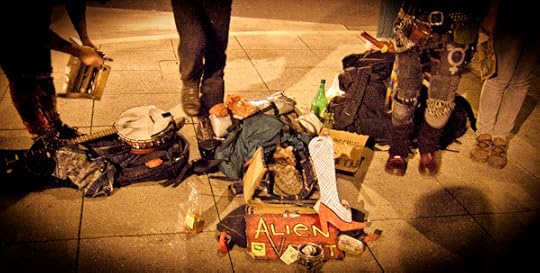
We saw a band of street musicians in Santa Cruz who call themselves Alien Vomit, kind of a good name. They use an accordian. It's the old Camper Van Beethoven heritage.
The fun thing about the Siberia book is just how different things are in Russia. The author insists on seatbelts in the van, and learns that nobody in Russia ever wears seatbelts. The only time he ever saw anyone use a seatbelt was when they took it out of their car and used it to connect the rear bumper to the front bumper of another car so they could tow it.
[image error]
Humongous sunset in Cruz today. On the campus radio station they were playing reggae and calling the town "Rasta Cruz."
I'm sorry to have finished my Siberia book, it was fun to live inside it for a week. Highly recommended.
Rudy Rucker's Blog
- Rudy Rucker's profile
- 583 followers




